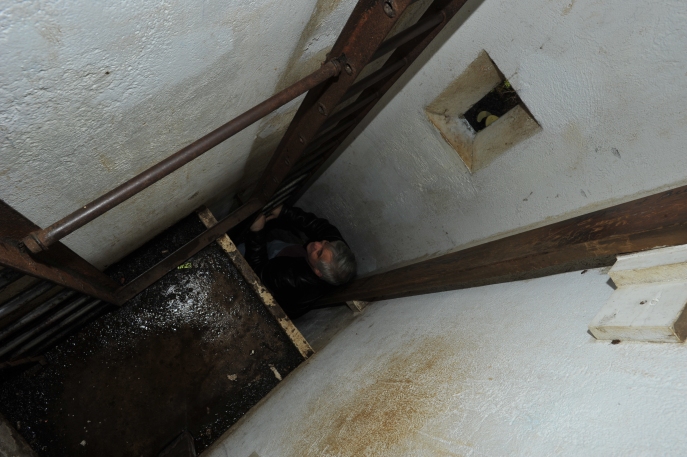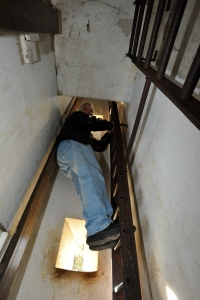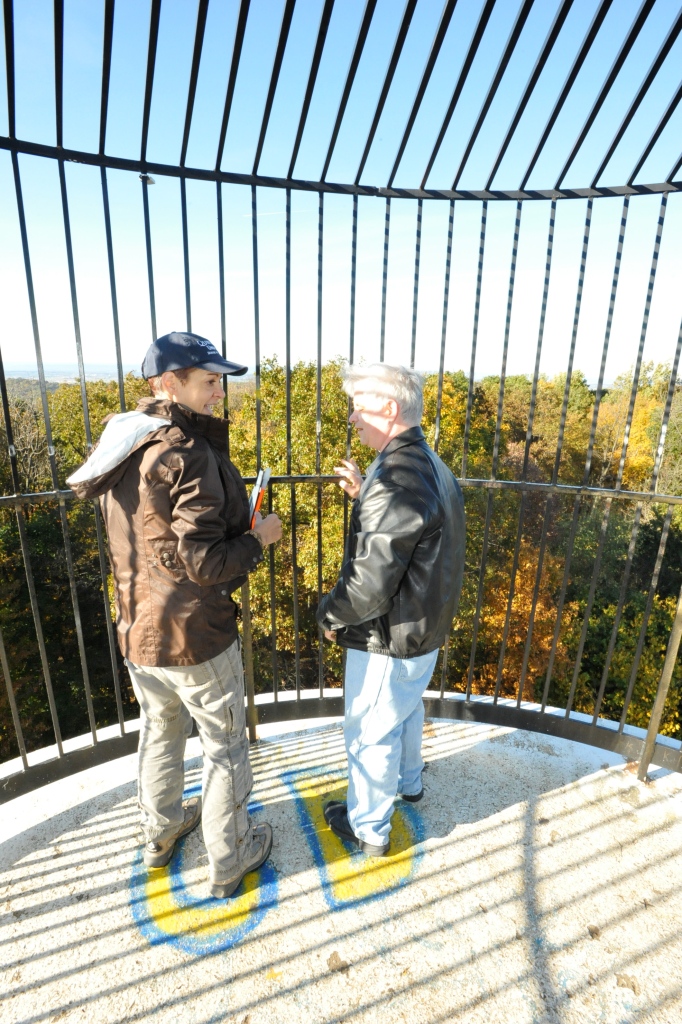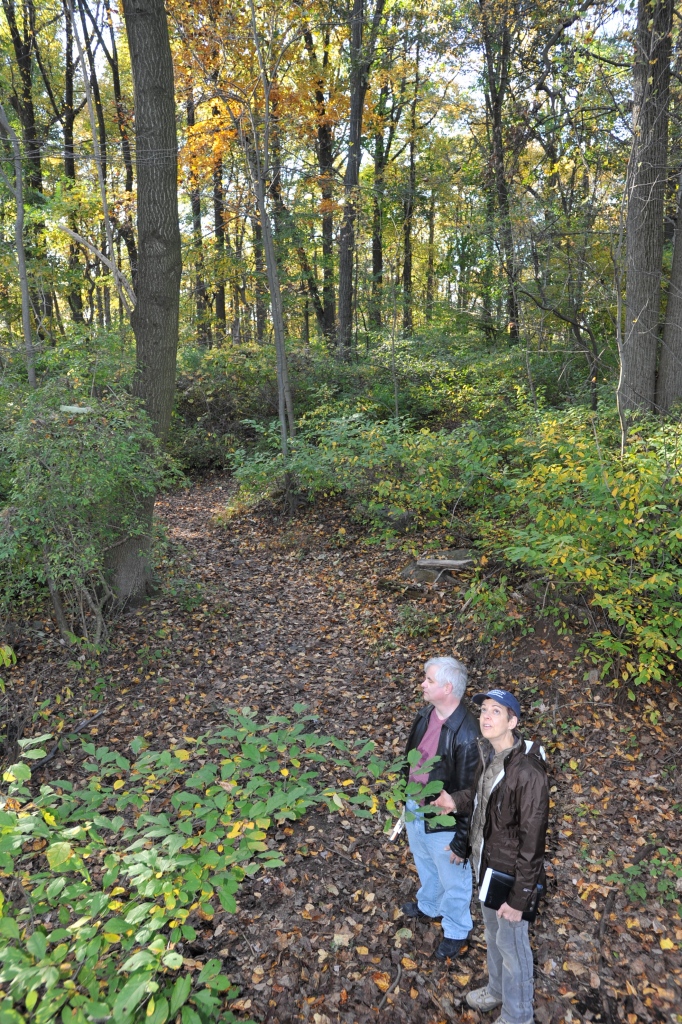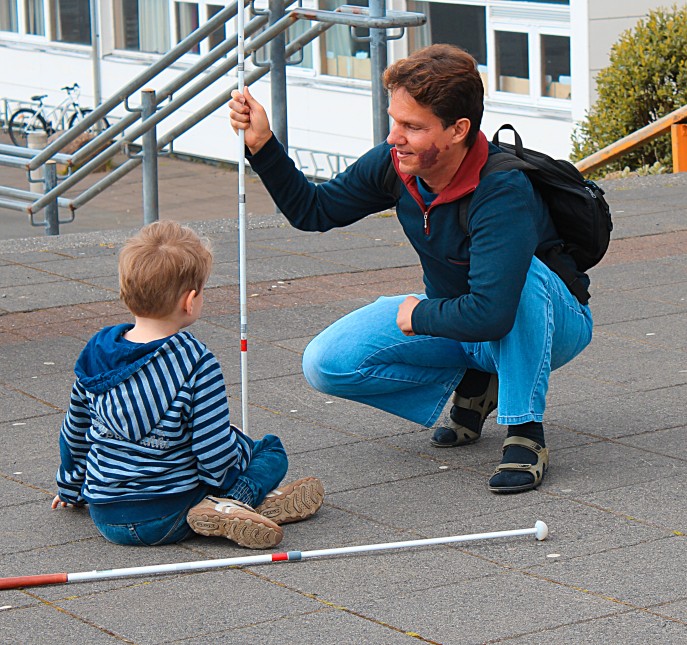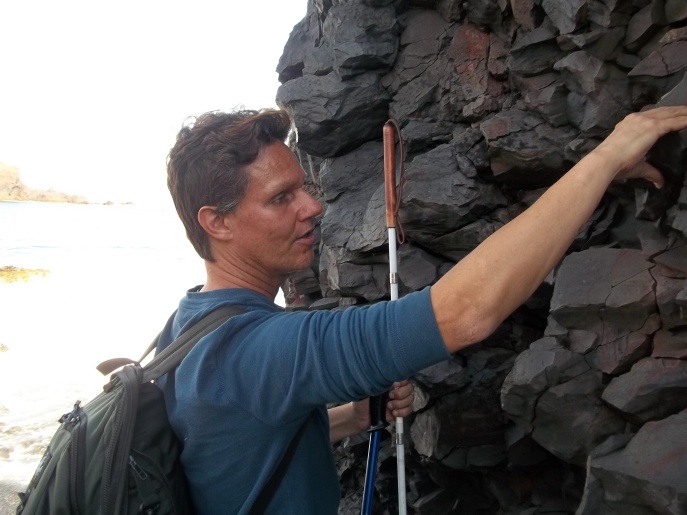You are standing in a dank, confining space. Spread your arms and you’ll touch concrete walls to either side. Walk just a few steps further in and you might smack into a concrete slab. You can turn 180 degrees on your heels and head straight back out into the fresh autumn air, or you can climb the iron ladder set flush to the wall to your immediate left.
You choose to climb.
A breezy downdraft carries the sounds of bodies and feet shuffling somewhere above. A startled echoing shout decries the stinkbugs colonizing the space above your head. But you climb steadily, your hands grabbing rung after cold rung, your toes bumping the wall because the ladder really is that shallow. Your hands find the top rung even as you realize you’ll have to stretch one leg across open space to shift to the next climbing platform.

Just one more ladder to go!
Reporter Katherine Jurgens and Brad Barrows about to gain the tower’s deck. Photo: Frans Jurgens
You do this ten times, scaling iron ladders, crossing open space, zigzagging your way up a tight vertical shaft even as the drop grows increasingly perilous, even as the draft strengthens all around, tugging your hair and your clothes until you finally emerge, exhilarated and triumphant, through a hole in the center of the deck of an observation tower you are sure must be rocking in this massive wind!
Now imagine you’ve done this in darkness. Utterly impenetrable complete darkness.
Imagine you’ve climbed a 66-foot observation tower for the thrill of the climb – but can’t see the view from the top.

Park Naturalist Dianna Sprucebank said Barrows is the first blind person to climb the Observation Tower at Clarence Schock Memorial Park. “When I learned of his climb it started me thinking. I spend a lot of time trying to get visitors to look up from their phones and into the woods. They’re blind in a different fashion. It’s an awareness thing. It’s a big issue. I realized now I need to try to focus on getting them to experience what’s in front of them through all their senses, not just by seeing but feeling , touching.” Photo: Frans Jurgens
Except; not being able to see isn’t the same as not perceiving. Or sharing: as Brad Barrows did when he and this reporter stood on the deck of the Governor Dick observation tower at Clarence Schock Memorial Park in Lebanon, Pennsylvania October 19, 2014.

Naturalist Brad Barrows and reporter Katherine Jurgens at the of the Observation Tower at Clarence Schock Memorial Park, Lebanon, Pennsylvania. Photo: Frans Jurgens
“Wow!” Barrows beamed as he gained the deck. “I can feel the sun on my skin. The strength of the wind. Wow!”
“Wow” is more of a motto than an exclamation when Barrows uses it. And he uses it a lot: cheerfully, generously, sometimes in puzzlement, yet ever optimistically.
Born without retinas, Barrows, 54, of Harrisburg, Pennsylvania, has been blind all his life. That didn’t stop him from wanting to share a view he couldn’t possibly “see” – to actively share it – by participating in its partaking. And this gentle, affable man; someone who’s never known the depth of an azure sky or the blush of an apple, or the sun-edged wings of the red-tailed hawk soaring, right now, above our heads…has just asked me to describe the colors of everything in sight.
How? How to translate this pristine, color-saturated patchwork of villages and farmlands; a veritable cornucopia of quintessential Amish Country cradled by rolling hills of gold, orange and green? This scene surrounded by yet more distant mountains that fade into a bluish haze…“Hmmm. If you could run your hands over the autumn hills they might feel like a bumpy quilt. Different nubs and ridges could convey different flavors? Some patches taste like orange? Some…? What does bumpy green taste like? Broccoli?”
Barrows laughed a polite, “Mm, yes.”
Okay, this is where simplistic analogies break down but he appreciated the effort as a starting point of a shared experience.
He leaned into the wind and made his way forward, reaching until his hand found the metal cage that encloses the observation deck. Being familiar with the local geography, using the round deck as a compass, he told me the names of the villages to the north and west by measuring my descriptions of steeples, silos and sub-divisions against the feel of the sun on his face. These reference points grounded him even at the top of a tower.
Barrows knew exactly where he stood within the space of the moment: his immediate environment and the world all around. Something that, if you close your eyes and think about it, could be difficult to achieve in the dark…with chattering voices swirling around and a brisk wind buffeting you and oh yeah there’s that hole somewhere behind you and …I open my eyes, not wanting to contemplate it. “Brad?”
He’s chatting with other sightseers, setting them straight on which direction they’re facing. They’re mostly startled and politely amazed to realize they’re sharing the deck with a blind person who’s just climbed the same tower they did.
It’s this intersection of encounter and realization that determines whether a connection is forged or a conversation abandoned. Will the sighted conquer reflexive assumptions or will their inner boy or girl scout presume to take the blind person in (literal or allegorical) hand and guide them to ‘safety’? Will the blind stand their ground and conduct themselves with an assurance that broadcasts self-reliance or let themselves (whether they wish it or not) be shepherded through life?
Barrow’s moment on deck was defined by a casual confidence that encouraged the typical banter and pleasantries that mark a communal experience. Did his sighted deck-mates return to earth with an experience that might shape their reaction to the next blind person they encounter? It’s a subject worth pursuing.
With the shaft’s pattern of gaps and ladders committed to spatial and tactile memory, Barrows made short and capable work of the descent, besting this white-knuckled reporter’s return to terra firma by several fluttering heartbeats! Making our way back along the leafy trail to the park’s visitor center, he used the tip of his white cane to feel for sneaky toe-catcher rocks, fallen branches; all the typical woodland trip-hazards.
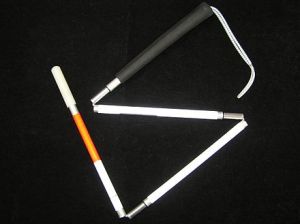
http://en.wikipedia.org/wiki/White_cane
Author: Sarah Chester 2007-09-12
On our mile hike to the tower he’d held one end of the cane while I gripped the other, me walking in front, he deducing which way the trail was bending by the movements telegraphed along the cane’s length. Now familiar with the trail’s character, he tapped his cane a few steps ahead of an unassisted, high-stepping gait.
He was duly smiling at his achievement. I was still trying to process what he’d just accomplished. Part of me inwardly grieved for what he wasn’t seeing. A piano tuner and musician by trade, Barrows was reveling in the forest’s acoustic subtleties, the raucous crows and affronted jays, the swish of leaves under foot, the rustling canopy above.
But what of the forest’s panoply of color: burnished copper, claret and gold? His fingers could explore the velvety pelt of moss covering the log we passed, he could smell its punky richness, but the contrast of emerald moss against sleek brown bark remained hidden from him. I kept these thoughts to myself, suspecting they were as likely presumptuous as misdirected.
And indeed, a “perceptual navigation coach” would later set me on a path to another perspective, but for now…I dispatched my melancholy with a wry observation. “An acrophobe and a blind guy. I still can’t believe we did that.”
Barrows grinned and said he’d decided on the spot to climb. “As soon as we entered and I could hear people talking somewhere up the structure. It was a bolt out of the blue. When I could tell folks were enjoying the tower, I just had to get up there.”
Gripping the passenger door of my Subaru Forester, maneuvering into its less than familiar confines, he tilted his head thoughtfully and said it is logistics – considerations like transportation and the company of amenable sighted hiking partners when required –that can cheat the blind out of interacting with nature, certainly out of spontaneous adventures like the one we’d just enjoyed.
“There’re benefits to enjoying nature and sharing the experience,” he said. “I feel freer outside. It helps me think. And sometimes, it’s just good to walk with somebody.”
Except, Barrows finds those occasions he spends enjoying nature with blind peers as brief as they are infrequent.
“Many blind and visually impaired people just don’t want to move beyond their comfort zones.” He gave a frank shrug and recalled leading a small group tour along a two-mile gravel and dirt path to a cider treat at an apple orchard. “I thought this was a glorious autumn hike, but some of the participants thought crossing a rough old stream bed and taking on a long but gradual climb was a bit more than they were ready for. Mm, yes,” he mused, but then brightened as he posed this challenge: “How do we get more blind people off the couch and on the trail?”
PERCEPTUAL NAVIGATION
“I know people who have gotten off the couch,” said Daniel Kish, founder and president of the non-profit charity: World Access for the Blind (WAB). “I fairly regularly encounter people who want to get more into the outdoors; people who are interested in hiking, a bit of tree climbing, people who did these things before they lost their vision and want to reclaim their ability to participate in these activities.”
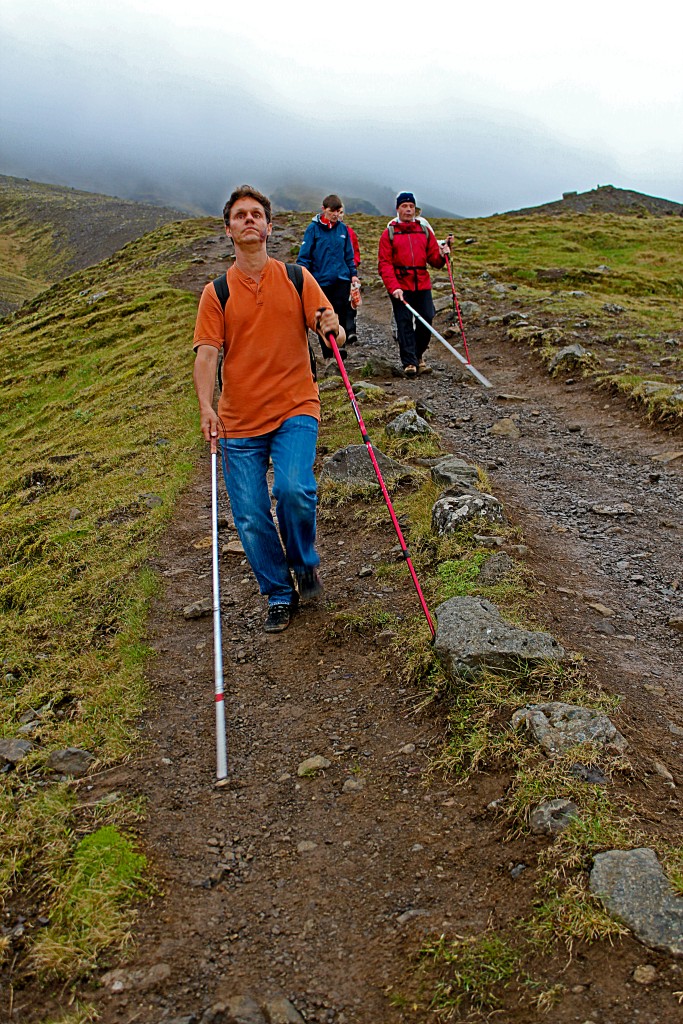
World Access for the Blind Founder and President Daniel Kish leading hikers along a mountain pass. Photo provided by: Daniel Kish April 16, 2015
Kish hasn’t simply encountered such people along a trail (or up a tree) – he’s often the mobility coach who helped them find their way there. Indeed, with uncompromising zeal (grounded in degrees in developmental psychology and special education) he is as determined to enable blind people to lead active, self-reliant lives as he is to liberate sighted people from their assumptions about what blind people can and can’t do.
.
“My passion isn’t about blindness it’s about freedom,” Kish avowed, his tone reflecting the steady conviction that marked all our exchanges. “I am passionate about the freedom of everything, the growth and integrity and quality of life and livelihood and freedom of every living thing. But blind people through history, and in modern society, are particularly susceptible to being restricted and restrained.”
Kish contends it’s the dynamic of sighted assumptions and blind adherence to restraint that combines to create the low expectations that keep Barrow’s would-be hiking companions rooted to their “comfort zones.”
“Most blind infants, children, teens and young adults have an incredible parental and social scaffolding that gets built up around them,” he said, “scaffolding that restrains and limits them, physically manipulates them, guides them here, pulls them there, until any budding perceptual navigation abilities are deconstructed, destroyed before they can develop.”
Well, except…not in this particular blind person’s case.
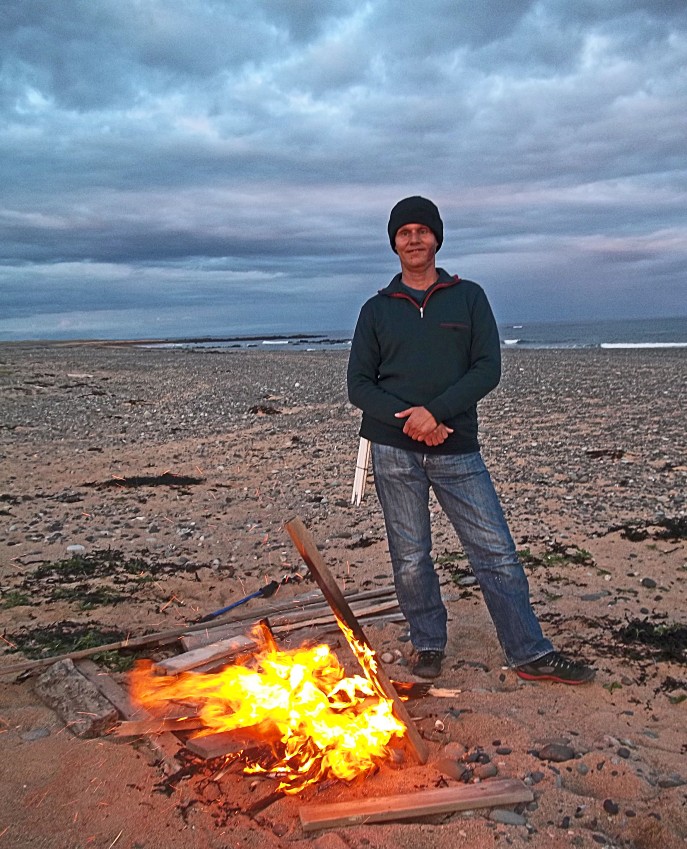
A sense of adventure fuels Daniel Kish’s educational and charitable work. Photo provided by Daniel Kish on April 16, 2015
“I grew up in a rougher area of Montebello, California,” said Kish. “My parents were young and in a low-income kind of situation. They didn’t have the resources for the interventions generally afforded blind children.”
Interventions that might otherwise have occurred because Kish, now 49 and living in Long Beach California, was born with a retina destroying cancer known as retinoblastoma. Both his eyes were removed in infancy to save his life and he reckons he “started developing perceptual navigation from about the age of 15 months.”
Meaning? He intuitively engaged all his available senses – including a nascent ability to bounce tongue clicks (and his toddler-self) off walls, floors, doorways; essentially every obstacle and opportunity in his path, and use the returning echoes to perceive and navigate his surroundings. He credits these robust and unimpeded early explorations as the key to his enduring autonomy.
“My parents didn’t know there were options,” he said, “so I grew up just like a regular kid, including bumps and bruises, riding the school bus, later walking to school. I’m pleased about that. Otherwise, my childhood would have been restrictive, limited. It would have deconditioned my natural free spirit.”
Kish is certain that free spirit is what allowed his brain the room it needed to develop the “flash sonar architecture” the above-mentioned protective scaffolding would otherwise “undermine or destroy.”
Flash Sonar is the term Kish coined to describe human echolocation – a skill akin to the way bats and dolphins generate sonar-like clicks, chirps and squeaks to locate their prey. He maintains (and research indicates) humans can learn to click their tongues in a way that generates echoes laden with rich, perceptual information if circumstances require (and lack of restraint permits) the brain to switch its imaging mechanisms from a visual to acoustic bias.
He adds “flash” is the closest way to describe the “nature of the signal” a tongue-clicking human generates. He describes these echo signals as “very short, very sharp, very penetrating – like the flash of a camera.” In fact, MRI scans have indeed shown that for some exceptionally practiced people, like Kish, these signals are robust enough to “flash” against the brain’s visual cortex.
Against the blind person’s visual cortex, okay – but what does that look like to their mind’s eye?
“Flash sonar is not a signal you have to deduce,” explains Brian Bushway, Kish’s 32-year-old protégé and a WAB perceptual navigation coach. “It’s not beeps and drones and the boop-boop-boop a sonar operator learns to interpret. Flash sonar is more natural than that. There’s no code we are using; no more than you break down and interpret light waves into codes to have vision. There just is a presence.” He paused, seeking to describe the ineffable nature of the experience. “It just is.”
Kish delved deeper. “Flash sonar conveys the general shape and location of objects, obstacles. I describe it as ‘fuzzy geometry.’ Edges and boundaries are there and they do register, but they are fuzzy and indistinct, especially if they’re near other objects.”
As for the quality of information gleaned? “More practiced individuals get a sense of size and contour,” said Kish. “There’s a form factor, a sense of density and texture, position and location, but again, the quality of these impressions depends on practice and experience.”
Considering Kish’s “unrestricted childhood,” plus the fact he was developing flash sonar in correlation with his first baby-steps, you might wonder if being born blind (or becoming so in infancy) factors into his deft capabilities. He agrees it’s a fair question and says, “WAB has worked with over thousands of people in 40 countries and I can think of a handful, less than ten, who didn’t develop some degree of ability.”
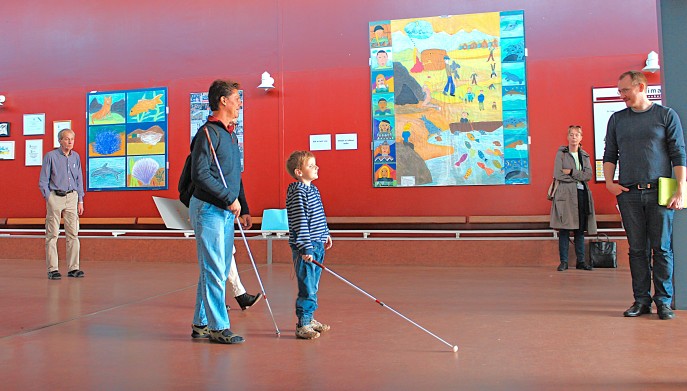
WAB is a 501 c (3) non-profit charity. Though the costs of its perceptual navigation workshops depends on the number of students and instructors involved, they average roughly $95 per hour. Scholarships are available.
Photo provided by: WAB
“We teach a skill,” said Kish, “and like any skill, anything anyone embarks on, it’s something people will learn to different degrees and applications, something they’ll apply in different ways. Most everyone can learn to play the piano,” he observed pragmatically, “but not everyone plays Carnegie Hall.”
Bushway hesitates to apply the Carnegie Hall metaphor, feeling it could prevent less confident people from approaching WAB or considering themselves able to pick up the clicking technique.
SELF-RELIANCE + MOTIVATION = SOCIAL MOBIITY
Bushway, 32, of Los Angeles, California, was the kind of kid who was always running around, climbing trees, riding bikes, playing hockey. But his playing field shifted when he was in his early teens. He started missing easy pucks; realized he was having more and more trouble making out the blackboard in class. His doctors diagnosed optic nerve atrophy and he went completely blind by the age of 14.
“Losing my vision screwed up my life socially more than anything else,” said Bushway. “For me, it was a matter of how do I keep up? How do I navigate the social waters? I was socially motivated.”
Bushway said that’s where “intuition” kicked in.
“Intuitively it made sense the more I could be connected to a physical environment the more ways I could understand it. I realized if I could walk into a room, give a couple clicks and triangulate the corners, I could get a shape of a room, its acoustic image. If I could do that, I could walk around and talk to people. It’s something I started doing on my own, along my high school’s corridors. As my other senses came on line, I started learning how to trust and actively take ownership of developing them.”
With emphasis on the word active!
“Jumping on a mountain bike; practicing clicking by following the sound of a zip-tie on the wheel of a bike in front, that’s a lot to process moving at fast speeds. That’s a very demanding cognitive load, so in a sense, after a bike ride, the next day walking around my high school’s going to be easier.”

Photo provided by: World Access for the Blind
Bushway said he didn’t have a clear concept, or even a name for the tongue-click navigation he’d taught himself until he met Kish at a pancake breakfast hosted by the Braille Institute of Orange County, California. “I met him the same year I became blind. He explained flash sonar, took an interest in me and became my mentor.” Bushway said fondly of the time Kish spent helping him develop his flash sonar skills, “It became one of the most positive relationships ever. I joined WAB soon after I graduated from Pepperdine University and have worked as a perceptual navigation coach and a motivational speaker ever since.”
Sympathetic to Barrow’s “off the couch and on the trail” challenge, Bushway said, “It’s my job as coach to ask what are the social and interpersonal obstacles against freedom of movement? Our work is about giving blind people, blind children in particular, permission to do the natural, age-appropriate thing.”
With heart-felt emphasis on the word ‘normal,’ Bushway added, “It’s normal for any toddler learning to walk to get bumps, scrapes and bruises. It’s only by moving, by getting into spaces and getting a hands-on, full-body interactive experience with their environment that they gain freedom of movement. Freedom of movement is a value we need to practice.”
A value a visiting Japanese student practices with relish.
RIBS AND RESILIENCE
For the past two years Ryo Hirosawa, 39, of Fukuoka Japan has spent spring break from his acupuncture and massage studies at the Fukuoka Special Needs Education High School for the Visually Impaired to embark on WAB workshops with Bushway.
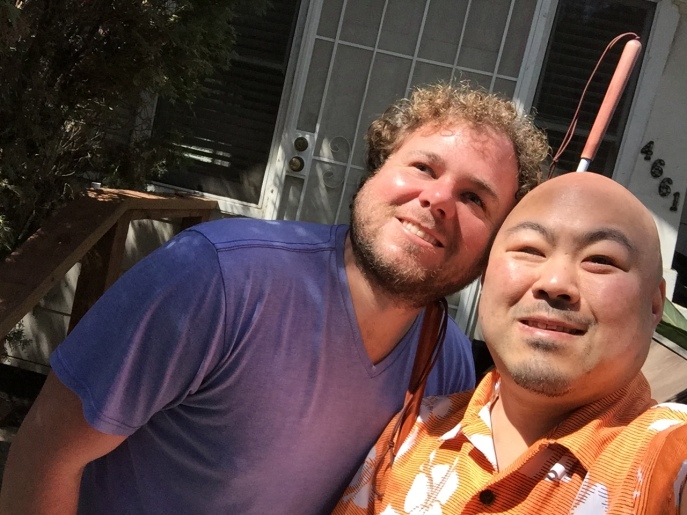
WAB Perceptual Navigation Coach Brian Bushway, left, and Flash Sonar student Ryo Hirosawa Photo by: Ryo Hirosawa
“I lost my sight in 2008,” Hirosawa related in a recent email from his home in Japan. “The direct cause was glaucoma caused by heart disease. I had quite good vision and was able to drive right up to the day I lost my sight. It happened after I’d arrived at my office. My vision suddenly blurred and I had a massive headache. I retained the sense of light for about a few months, and then it got completely dark.”
Hirosawa said a Canadian friend directed him to World Access for the Blind’s flash sonar training sessions through its Facebook page. Investigating further, he felt he’d discovered a way to reclaim some of his former independence.
Having recently completed his Spring-2015 training sessions with Bushway, he said, “I have a vague idea of the things around me. However, perceiving objects is totally changed from sight to auditory. I’m still struggling with how I can ‘see’ with flash sonar.”
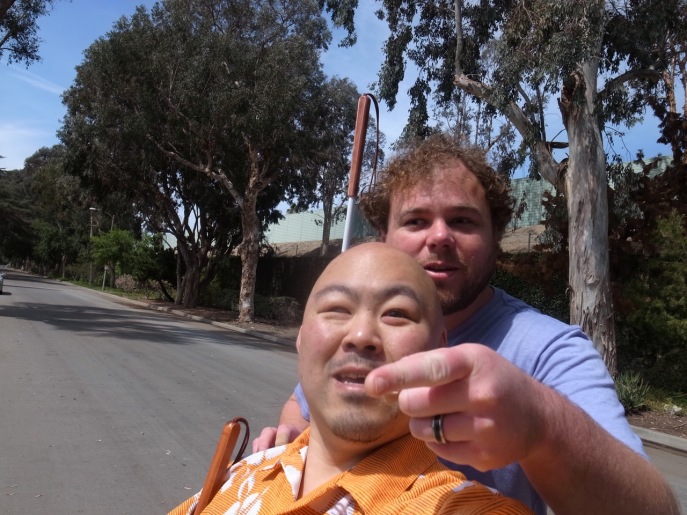
Bushway and Hirosawa practice navigating a neighborhood street near Los Angeles. Photo by: Ryo Hirosawa
Yet he affirms the struggle is worthwhile. Pointing out that he’d just flown back and forth between Japan and North America – with multiple pre-workshop side-trips to visit historic places and friends in Washington DC, Pennsylvania, Toronto, Calgary and San Francisco – he said, “I wouldn’t travel so much if I didn’t have confidence. Flash sonar does not only help me develop perceptual mobility, it helps build confidence!” It should be noted Hirosawa accomplished these flights and connections as a solo traveler.
Hirosawa described his recent two-day workshop with Bushway as a warm up of flash sonar clicks against a panel that progressed to on-site training on a lightly trafficked street, a busy sidewalk and then a relaxing walk in a nearby park. Happy with his progress, he said the second day’s session ended with the celebration of a goal staked and happily met.
“Brian and I ate lunch at Johnny Reb’s Southern Roadhouse because one of my goals was to have beef ribs. Most blind people give up on freedom, independence and responsibility but Brian helps me to gain even the freedom of eating what I want to eat! Flash sonar does not only give mobility, it helps me reclaim myself as an independent person.”
Including the freedom to venture into the wilderness?
“I am a ‘conservative’ in the sense of the word conservation,” said Kish, his voice deepening with conviction. “I value life and anything that has a respect and appreciation of its own life. Who am I to deny that appreciation? Yes, I take pleasure in exploring nature. I am probably most relaxed and at rest when I’m 50 feet up a tree.” He gave a light laugh. “That’s where I feel most at home, barefoot and in a tree.”
OR UP A TOWER?
Bouncing the possibilities of flash sonar off Barrows, he said, “I’ve heard of it, but I didn’t click my tongue while we climbed the tower. I do sometimes tap the side of my leg or cluck my tongue to get an echo around me.”
Thinking about it further, he touched on Kish’s views on the innate nature of perceptual navigation when he added, “I suppose one could say my own version of echolocation has always been part of my life, but it just came to me. I was never formally taught to use it.”
What he was taught, or rather introduced to, was the thrill he gains when he sets off on a hiking adventure.
“My Uncle Joe felt it was important for me to plunge into nature. He was my wilderness mentor and created a lasting impression when he started me trail walking at about the age of 8.”
Barrows said his 20s and 30s found him hill-walking sections of the Adirondacks with sighted companions, also portions of the Green and White Mountains of New Hampshire. In more recent years he’s enjoyed more gentle forays through Pennsylvania’s Clarence Schock Memorial Park and Weiser State Forest.
But, whether joining a sighted hiker along a rocky, switch-back trail; or ambling with his walking stick along a grassy slope, Barrows contends feeling confident in the woods, any unpredictable natural setting, translates to greater self-reliance navigating life in general.

Brad Barrows plans to hike this Dauphin County, Pennsylvania stretch of the Appalachian Trail.
Photo: Katherine Jurgens
He passionately feels exploring a wilderness setting with all its ever-changing unknowns of weather, obstacles, textures and sounds…provides the blind with moments of serenity and connection, while building confidence and self-esteem, just as it does for anybody.
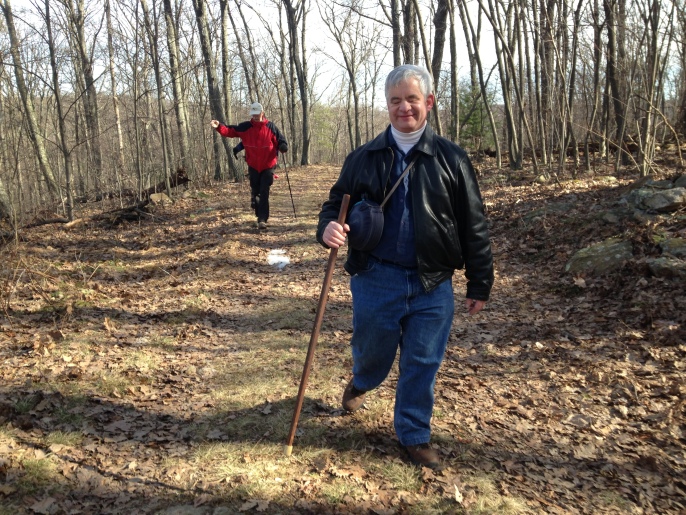
Brad Barrows hiking in Pennyslvania’s Weiser State Forest, March 2015.
Photo by: Katherine Jurgens
Barrow’s sentiment is one Kish and Bushway adamantly share, and put into practice during WAB perceptual navigation sessions.
“I agree one of the many benefits of nature is its variety,” said Bushway. “It invites curiosity. Curiosity is a process, a perceptual approach. In nature, you say: ‘I hear something out there. What is it? Let’s go and discover.’ I’m going to self-direct and learn through that discovery. It brings life, going out into nature.” He paused and you could hear the smile in his voice. “Nature is beautiful. It feels different, sounds different. I’m using everything when I’m exploring it.”
“We all live in a nature deficit culture,” added Kish. “We can all, sighted and blind, benefit from a wilderness experience. But for the blind to achieve it, we need to get away from dependency conditioning. That needs to go.”
Dependency conditioning, or learned helplessness, is a subject Kish explores during his frank TED Talks presentations. Deploying an often wry wit, he invites everyone, sighted and blind, to consider the self-confidence (and flash sonar) quashing burden society’s “low expectations” inflict on some people simply because they don’t perceive the world through vision.
Kish further explains: “There’s a strong societal tendency to limit, restrict or structure the otherwise self-guided movements of blind children – regardless of how well they’re getting around. There’s a tendency to really want to attach these kids to someone or a surface, to a sighted guide.
“For a typical infant,” Kish continues, “the parental dynamic will usually look like a gradual removal of scaffolding parallel to the baby’s developing abilities. Take walking for instance. With a sighted infant, parents initially support then back off quite naturally. You call the infant toward you. The infant toddles, falls; learns that’s not a big deal.
“It’s that organic process, that natural withdrawal of support that steers the infant forward to develop greater capacities. That does not happen with blind kids by and large – not that organic capacity for building skills. Most blind kids are heavily supported, manipulated, prodded, puppetted and nudged through the environment. The infant comes to depend on that degree of structured and manipulated interacting,” stressed Kish. “I call that dependency conditioning: a collapse of organic capacities and capabilities. These infants become so dependent on others for perceptual information flash sonar can’t develop.”
In fact, it was his unsettled adolescent realization that most of the other blind people he met depended on others to make their way through life – combined with interviews and research he conducted while writing his thesis for one of the two masters degrees he holds in Developmental Psychology and Special Education – that led to the creation of WAB and its perceptual navigation workshops.
“Perceptual navigation means engaging the whole brain,” said Kish. “It means using all available senses, including flash sonar, to ground yourself in your environment and then “move freely through that environment with minimal reliance on others.”
He expands his definition of minimal reliance with a caveat regarding outdoor adventures that pair sighted guides with blind participants.
“That’s fine. That’s a choice someone makes. But it won’t be as direct a self-discovery. I say this to play devil’s advocate. It’ll be a different kind of experience. And, either way, you may feel edified by the wilderness.
“Where I take issue, where I raise a red flag… is how much responsibility can you take for yourself? You don’t want to be potentially burdensome,” he said gravely. “You don’t really want to be the one who is causing others inconvenience, who can’t manage their stuff.That’s what I would caution people to think about if they want to get active in outdoor activities. They need to have really good self-help skills to be able to be in touch with environment around them.
“For example, I was in Iceland with a friend who wanted to show me his country. Iceland has a lot of deserted places. We were out at a beach campsite area for summer solstice. He chose the furthest site out from the base camp.”
He laughed, recalling the remote setting. “There’s a dirt trail, and then a grass path that’s been patted down by feet. You follow the grass path until it opens into a big meadow.” That’s where his friend chose to set up camp. “I used the rest room before I left the base camp, taking careful note about where it was and how to get back to it should I need to because I will damned if I’m gonna wake someone up in middle of night…”
Well of course he found himself heading back to the base camp restroom later that night.
“I found it quite easily – it was getting back that was tough!”
Imagine trying to find a small tent in a large meadow in the pitch dark of night, without the possibility of the moon or a flashlight. Kish said he’d have to approach within 15 to 20 feet of the tent to gain useful flash-sonar feedback.
“You want to know my biggest concern at the time?” he asked dryly. “Someone comes along and I don’t speak Icelandic and they don’t speak English. If someone comes along and happens on a blind person in that situation… Well you’re going to have an awkward difficult encounter and worse, I can’t even tell them where I’m trying to go! It’s better to be left alone and not have well-meaning people in my face… That’s an example of what I mean by potentially burdensome. If I hadn’t had those self-reliant skills, the confidence that goes with them…” his voice trailed off.
“When we talk about liberation of blind people, we tend to talk more about it in terms of freedom rather than independence,” concluded Kish. “We regard it in terms of an individual being able to enjoy the same freedoms and responsibilities as equal citizens in a given culture.”
But, for those who’ve yet to gain self-reliant, perceptual navigation skills? Or are taking their first steps exploring beyond their personal comfort-zone? National and local advocacy groups may afford an alternative path to nature.
SHARING RESOURCES AND WISDOM
“I’ve always been big on outdoor adventure,” said Beth Rival, 61, of Berlin, Connecticut. “I swim at the ocean, walk on the beach. It’s a great stress release.”
Rival’s hiking buddy, Maryanne Mellui, 56, of West Hartford, Connecticut, agreed. “You feel freer outside. I love hiking. I climb Madadnock every fall. I climb the White Mountains in New Hampshire. I snowshoe. It just proves to people in general that just because I’m blind doesn’t mean I still can’t do these things that you do. If you’re an outdoors person, which I already had been and Beth already had been, I still am that person. Just because I can’t see…I’m still that person.”
Rival nodded at the defiance in her friend’s voice. “Yes. I still love walking in the woods, listening to the birds. I have an app on my iPhone that lets me identify birdcalls. It’s awesome. But it’s a different way of enjoying nature. The sighted don’t understand it. They find it hard to relate to our way of exploring.”
Rival clapped her hands together for emphasis. “That’s why you hook up with agencies, organizations. You need peers and groups to access resources, to find activities and follow interests. These aren’t social cliques, but a chance to share each others solutions and technology.”
Rival and Mellui base their insights on direct experience. Rival’s a past president and current second vice president and board member of the Hartford-based National Federation of the Blind of Connecticut (NFBCT). She was declared legally blind at 19 and went completely blind at 45 due to rheumatoid arthritis complications, including swelling, cataracts and glaucoma.
Mellui is a former NFBCT secretary and current board member. She’s married, has two daughters, and works for Silver Lining Technologies of Hartford, fitting clients with low vision and blindness products including assistive technology like video magnifiers. She’s been legally blind for 11 years.
Rival’s just as active, with two daughters and four grandchildren – plus another on the way. She works part time designing spreadsheets for Nutmeg Senior Rides, a not-for profit Connecticut organization that provides transportation for seniors and disabled adults through a network of volunteer drivers.
Mellui said she felt “lost” when she was declared legally blind. To get a better idea of what that means: consider that a legally blind person with glasses or contacts will see an eye chart at 20 feet as well as a person with normal vision will see it at 200 feet.
“I felt there was no one my age that I could get in touch with,” continued Mellui. “So, joining an organization was wonderful for socialization. It let me find out what’s available. It’s great to be able to relate to what’s happened to somebody else, to be able to share our technology, to share knowledge You find someone who is close to your age that you can do things with socially and you know meeting Beth was one of the best things that ever happened to me.”
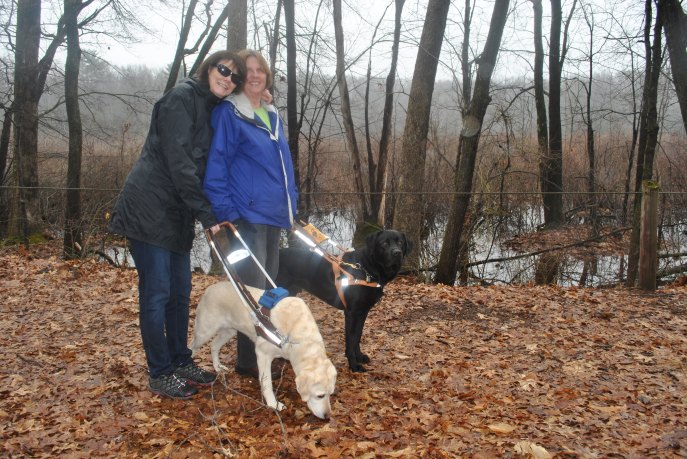
Maryanne Mellui and Beth Rival hit the trail with their dogs Aza and Finbarr
Photo by Katherine Jurgens
Speaking to Barrow’s challenge and WAB’s work, Mellui said, “More people need to become independent. It’s a problem with a lot of people who become blind later in life. It’s true. They’re more afraid to get off the couch, to try anything new. But, if you connect with other people you can get your independence back. You can do anything you want to do, just in a different way.”
Rival added, “You can still run a marathon for instance. There’s a group called Guide Runners for that. There’re lots of groups that can help you find the resources you need to continue an active life.”
Mellui nodded. “That’s why you connect with one of these national or state organizations; whether it’s the National Federation of the Blind, the American Council of the Blind or the American Federation for the Blind. You might not like all the people or everything about their approach, but you’ll meet at least one person who can teach you something.”
Including perceptual navigation?
Each said they are aware of flash sonar and know someone who employs it, but they prefer the partnership they enjoy with their guide dogs, stating that working relationship with their dogs combined with active roles in advocacy creates the best route to self-reliance for them. Indeed, they answered Barrow’s challenge by contending, whichever route you choose, exploring the world at liberty is more fun and interesting with peers who can share resources and acquired wisdom.
ON THE TRAIL TO DISCOVERY
We were sitting in the sun-drenched booth of a Harrisburg, Pennsylvania, diner, Barrows, his wife Mary, and me.
Mary, 71, was on her way to conduct a local choir, she being as musically inclined as her husband and also the other half of their singing duo: Daybreak. She’d agreed to join us for a quick bite as Barrows and I confirmed latitude and longitude coordinates for a Susquehanna Appalachian Trail Club hike at Weiser State Forest…a trail so not taken it flummoxed my GPS.
Waiting for our orders, chatting of this and that, Mary, who is sighted, smiled at Brad and reminisced, “He told me he didn’t know what blind meant until he was in the first grade at The Boston Center for Blind Children.” She gave a slight shrug, “As a small child, how could he have known that not everyone perceived the world the same way he did?”
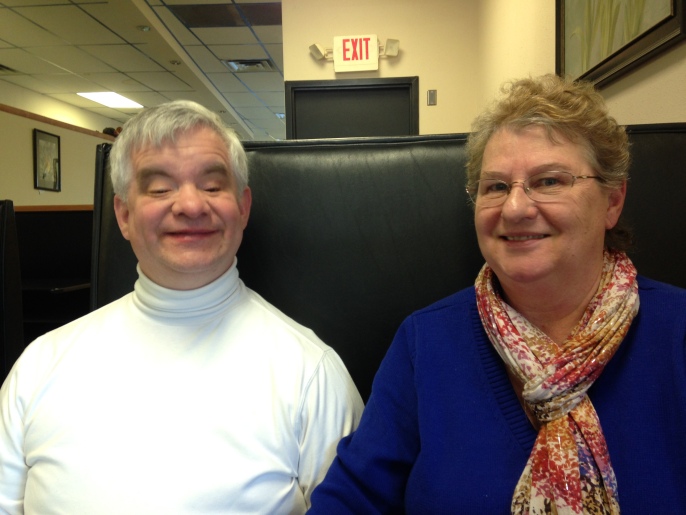
Brad and Mary Barrows
Enjoying each others company at a Harrisburg, Pennsylvania diner.
Photo: Katherine Jurgens
Barrows sat listening as Mary related, “The teacher explained it to him by placing a sheet of paper on his desk. She explained that there was something on that paper he couldn’t perceive. He, in his rebellious way (Brad’s grin widened), insisted, ‘There’s nothing on this paper.’ The teacher said, ‘Yes there is.’ That was how he came to understand that there was another way of perceiving that he didn’t understand.”
Barrows broke in with an emphatic, “Right.”
“Did that make you sad?” I wondered. “Or frustrated?”
“It made me curious. I didn’t find it sad at all.” He smiled broadly. “My first thoughts were, ‘Wow, I wonder what it is I’m missing?’”
He was determined to find out, has been ever since.”

Brad Barrows at the peak of the trail he hiked in Weiser State Forest, March 2015.
Photo: Katherine Jurgens
Story, Hike, Video and Slideshow by: Katherine Jurgens –
Now reporting for www.crywild.com
